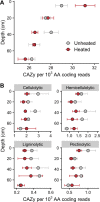Metabolic capabilities mute positive response to direct and indirect impacts of warming throughout the soil profile
- PMID: 33828081
- PMCID: PMC8027381
- DOI: 10.1038/s41467-021-22408-5
Metabolic capabilities mute positive response to direct and indirect impacts of warming throughout the soil profile
Abstract
Increasing global temperatures are predicted to stimulate soil microbial respiration. The direct and indirect impacts of warming on soil microbes, nevertheless, remain unclear. This is particularly true for understudied subsoil microbes. Here, we show that 4.5 years of whole-profile soil warming in a temperate mixed forest results in altered microbial community composition and metabolism in surface soils, partly due to carbon limitation. However, microbial communities in the subsoil responded differently to warming than in the surface. Throughout the soil profile-but to a greater extent in the subsoil-physiologic and genomic measurements show that phylogenetically different microbes could utilize complex organic compounds, dampening the effect of altered resource availability induced by warming. We find subsoil microbes had 20% lower carbon use efficiencies and 47% lower growth rates compared to surface soils, which constrain microbial communities. Collectively, our results show that unlike in surface soils, elevated microbial respiration in subsoils may continue without microbial community change in the near-term.
Conflict of interest statement
The authors declare no competing interests.
Figures






Similar articles
-
Altered precipitation and nighttime warming reshape the vertical distribution of soil microbial communities.mSystems. 2025 May 20;10(5):e0124824. doi: 10.1128/msystems.01248-24. Epub 2025 Apr 8. mSystems. 2025. PMID: 40197052 Free PMC article.
-
Soil fungal community has higher network stability than bacterial community in response to warming and nitrogen addition in a subtropical primary forest.Appl Environ Microbiol. 2024 Jun 18;90(6):e0000124. doi: 10.1128/aem.00001-24. Epub 2024 May 21. Appl Environ Microbiol. 2024. PMID: 38771056 Free PMC article.
-
Long-Term Warming Alters Carbohydrate Degradation Potential in Temperate Forest Soils.Appl Environ Microbiol. 2016 Oct 27;82(22):6518-6530. doi: 10.1128/AEM.02012-16. Print 2016 Nov 15. Appl Environ Microbiol. 2016. PMID: 27590813 Free PMC article.
-
Forest Soil Bacteria: Diversity, Involvement in Ecosystem Processes, and Response to Global Change.Microbiol Mol Biol Rev. 2017 Apr 12;81(2):e00063-16. doi: 10.1128/MMBR.00063-16. Print 2017 Jun. Microbiol Mol Biol Rev. 2017. PMID: 28404790 Free PMC article. Review.
-
Topological change of soil microbiota networks for forest resilience under global warming.Phys Life Rev. 2024 Sep;50:228-251. doi: 10.1016/j.plrev.2024.08.001. Epub 2024 Aug 8. Phys Life Rev. 2024. PMID: 39178631 Review.
Cited by
-
Soil bacterial communities associated with multi-nutrient cycling under long-term warming in the alpine meadow.Front Microbiol. 2023 Feb 23;14:1136187. doi: 10.3389/fmicb.2023.1136187. eCollection 2023. Front Microbiol. 2023. PMID: 36910214 Free PMC article.
-
Climate warming fuels the global antibiotic resistome by altering soil bacterial traits.Nat Ecol Evol. 2025 Aug;9(8):1512-1526. doi: 10.1038/s41559-025-02740-5. Epub 2025 Jun 4. Nat Ecol Evol. 2025. PMID: 40468041
-
Kinetic Properties of Microbial Exoenzymes Vary With Soil Depth but Have Similar Temperature Sensitivities Through the Soil Profile.Front Microbiol. 2021 Nov 30;12:735282. doi: 10.3389/fmicb.2021.735282. eCollection 2021. Front Microbiol. 2021. PMID: 34917043 Free PMC article.
-
Conservation tillage facilitates the accumulation of soil organic carbon fractions by affecting the microbial community in an eolian sandy soil.Front Microbiol. 2024 May 31;15:1394179. doi: 10.3389/fmicb.2024.1394179. eCollection 2024. Front Microbiol. 2024. PMID: 38881670 Free PMC article.
-
Genomic insights into redox-driven microbial processes for carbon decomposition in thawing Arctic soils and permafrost.mSphere. 2024 Jul 30;9(7):e0025924. doi: 10.1128/msphere.00259-24. Epub 2024 Jun 11. mSphere. 2024. PMID: 38860762 Free PMC article.
References
-
- Conant RT, et al. Temperature and soil organic matter decomposition rates—synthesis of current knowledge and a way forward. Glob. Change Biol. 2011;17:3392–3404. doi: 10.1111/j.1365-2486.2011.02496.x. - DOI
-
- Yost JL, Hartemink AE. How deep is the soil studied—an analysis of four soil science journals. Plant Soil. 2020;452:5–18. doi: 10.1007/s11104-020-04550-z. - DOI
-
- Dove NC, et al. Continental-scale patterns of extracellular enzyme activity in the subsoil: an overlooked reservoir of microbial activity. Environ. Res. Lett. 2020;15:1040a1. doi: 10.1088/1748-9326/abb0b3. - DOI
Publication types
MeSH terms
Substances
LinkOut - more resources
Full Text Sources
Other Literature Sources

